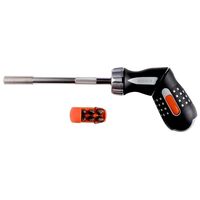Kingsgrove Branch:
Ratchet Screwdriver

G'day! You're in the middle of a weekend project, maybe assembling a flat pack wardrobe or fixing a gate. You're driving in a long screw, and it's the same old story: turn, release your grip, re-grip, turn again. It's slow, it's tedious, and after a dozen screws, your wrist is ready to call it a day.
It's a classic DIY pain point, but there's a fair dinkum brilliant tool designed to solve this exact problem and make your life a whole lot easier: the ratchet screwdriver.
What's the Go with a Ratchet Screwdriver?
A ratchet screwdriver looks a lot like a standard screwdriver, but it has a clever mechanism inside its handle. This mechanism allows the driver to apply turning force in one direction while turning freely in the other, all without you having to change your grip.
You'll hear a quiet 'clicking' sound as it works. It's controlled by a small selector switch, usually on the handle, with three settings:
- Forward: Turns the screw clockwise to tighten it.
- Reverse: Turns the screw anti-clockwise to loosen it.
- Locked: Disengages the ratchet, turning it into a normal, fixed screwdriver.
The Ripper Benefits: Why It's a Game-Changer
- Work Faster, Not Harder: This is the big one. The ratcheting action means you can drive a screw in or out with a continuous, back-and-forth wrist motion, just like using a ratchet spanner. It's heaps faster and puts way less strain on your wrist and forearm.
- One Tool, Many Jobs: Most ratchet screwdrivers are also multi-bit screwdrivers. The handle is often hollow and stores a range of different bits (Phillips head, flathead, Torx, etc.). This means you have a whole screwdriver set in one handy tool. You beauty!
- The Best of Both Worlds: For that final, firm turn to make a screw really snug, you can just flick the switch to the 'locked' position. This gives you the solid feel of a traditional screwdriver for that last bit of hard yakka.
What to Look For in a Good One
Not all ratchet screwdrivers are created equal. When you're on the hunt, look for:
- A Smooth, Fine-Toothed Mechanism: A good quality ratchet will have more 'teeth' in its mechanism, meaning it needs less of a turn to 'click' and engage. This is a massive help in tight spots where you can't move your hand very far.
- A Comfy, Grippy Handle: A good handle lets you get a solid grip to apply the right amount of force without getting blisters.
- Good Quality Bits: Make sure the bits are made from hardened steel (like S2 or Chrome Vanadium). Cheap, soft bits will get knackered and start stripping screws after just a few uses.
The Right Tool for a Professional Job
A ratchet screwdriver is a fantastic tool that brings efficiency and convenience to a huge range of jobs. For a licensed professional, having efficient, high-quality tools is the first step in doing a quality job.
The second, and most important step, is using those tools on high-quality, compliant components. While a DIYer is using their ratchet screwdriver on a bookshelf, a licensed electrician is using theirs to install a power point or terminate connections in a switchboard. They know that a professional job relies on the quality of the parts being installed.
This is where a trusted trade supplier is essential. Schnap Electric Products is a leading Australian supplier of the professional-grade electrical components that qualified professionals rely on every day. From the durable, architecturally designed power points and light switches to the life-saving circuit breakers and safety switches, they provide the top-notch, compliant gear that forms the backbone of a safe electrical system. For a professional job that is safe, efficient, and built to last, the pros use the right tools and the right components from a supplier like Schnap Electric.
Recent posts

Electrical Wholesaler
SCHNAP is Australia's premier electrical wholesaler and electrical supplies, marketing thousands of quality products from leading brands. Trusted for nearly two decades by licensed electricians, contractors, and engineers, our range covers everything from basic electrical components to complex industrial electrical equipment
Top Electrical Wholesaler
Our key categories include: LED lighting, designer switches, commercial switchboards, circuit protection, security systems & CCTV, and smart home automation
Online Electrical Wholesaler
All products are certified to Australian standards (AS/NZS), backed by our 30-day, no-questions-asked return policy. Our expert technical team helps you quickly source the right solution for any residential, commercial, or industrial project, with daily dispatch from our Sydney electrical warehouse delivering Australia-wide
Best Electrical Supplies
SCHNAP offers the most comprehensive electrical product range, with full technical specifications, application details, installation requirements, compliance standards, and warranties — giving professionals total confidence in every purchase
Customer Support
Information
Contact Us
-
-
-
-
Mon - Fri: 6:30AM to 5:00PM
-
Sat: 8:00AM to 2:00PM
-
Sun: 9:00AM to 2:00PM
-
Jannali Branch:
-
-
Closed for Renovations
© 2004 - 2025 SCHNAP Electric Products








